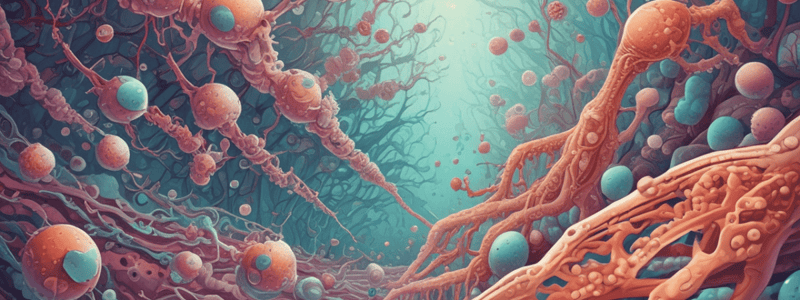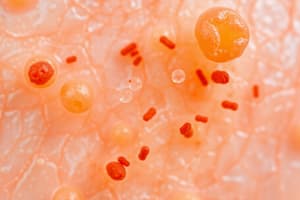Podcast
Questions and Answers
What is the primary mechanism by which bacteria form biofilms?
What is the primary mechanism by which bacteria form biofilms?
- Quorum sensing
- Adherence to host cells or prosthetic surface (correct)
- Invasion and multiplication
- Host response
Which of the following is NOT a symptom of infection?
Which of the following is NOT a symptom of infection?
- Purulence or erythema
- Headache (correct)
- Malaise
- Fever
What is the primary goal of diagnosis in infection management?
What is the primary goal of diagnosis in infection management?
- To determine the antimicrobial susceptibilities
- To identify the infecting organism (correct)
- To develop a treatment plan
- To monitor the patient's immune response
Which of the following bacteria is NOT typically associated with endocarditis?
Which of the following bacteria is NOT typically associated with endocarditis?
What is the primary function of quorum sensing in bacteria?
What is the primary function of quorum sensing in bacteria?
What is the primary challenge in diagnosing infections related to prosthetic surfaces?
What is the primary challenge in diagnosing infections related to prosthetic surfaces?
What is the primary aim of treatment in infection management?
What is the primary aim of treatment in infection management?
Which of the following investigations is NOT typically used to diagnose infections?
Which of the following investigations is NOT typically used to diagnose infections?
What is the primary function of the surface of the GI tract in relation to microorganisms?
What is the primary function of the surface of the GI tract in relation to microorganisms?
Which of the following microorganisms is NOT a type of fungus that can be found on the skin?
Which of the following microorganisms is NOT a type of fungus that can be found on the skin?
What is the primary cause of pneumonia?
What is the primary cause of pneumonia?
Which of the following is an example of an internal surface infection?
Which of the following is an example of an internal surface infection?
What is the primary characteristic of cystic fibrosis?
What is the primary characteristic of cystic fibrosis?
Which of the following microorganisms is commonly found in the skin and is a Gram-positive bacterium?
Which of the following microorganisms is commonly found in the skin and is a Gram-positive bacterium?
What is the primary site of infection for Pseudomonas aeruginosa in patients with cystic fibrosis?
What is the primary site of infection for Pseudomonas aeruginosa in patients with cystic fibrosis?
Which of the following is an example of an artificial surface that can provide a site for microorganisms to establish infection?
Which of the following is an example of an artificial surface that can provide a site for microorganisms to establish infection?
What type of adhesins are usually components of the bacterial cell membrane, cell wall or capsule?
What type of adhesins are usually components of the bacterial cell membrane, cell wall or capsule?
Which of the following prosthetic surface infections is NOT an example of an intravascular device?
Which of the following prosthetic surface infections is NOT an example of an intravascular device?
What is the approximate incidence of infection for primary hip replacement?
What is the approximate incidence of infection for primary hip replacement?
Which of the following microorganisms is NOT typically associated with early post-operative infections of joint replacements?
Which of the following microorganisms is NOT typically associated with early post-operative infections of joint replacements?
What is the main function of adhesins in bacterial infection?
What is the main function of adhesins in bacterial infection?
Which of the following is an example of a non-fimbrae protein adhesin?
Which of the following is an example of a non-fimbrae protein adhesin?
What is the typical duration of antibiotic therapy for prosthetic joint infections?
What is the typical duration of antibiotic therapy for prosthetic joint infections?
Which of the following is NOT a source of infection in an IV line?
Which of the following is NOT a source of infection in an IV line?
Flashcards are hidden until you start studying
Study Notes
Surfaces
- Interface between a solid and either a liquid or gas
- Natural body surfaces: skin, GI tract, urinary tract
- Artificial surfaces: intravenous lines, central venous line catheters, NG tubes, prosthetic devices, and implants
Microorganisms on Skin
- Viruses: papilloma, herpes simplex
- Bacteria:
- Gram positive: Staphylococcus aureus, coagulase negative staphylococci, Corynebacterium
- Gram negative: Enterobacteriaceae
- Fungi: yeasts, dermatophytes
- Parasites: mites
Mucosal Microflora
- No specific information provided
Natural Infection Sites
- External surfaces:
- Pharyngitis (sore throat)
- Conjunctivitis (infection of conjunctiva)
- Gastroenteritis (inflammation of the gastrointestinal tract)
- Urinary tract infection (infection in any part of the urinary system)
- Pneumonia (infection of one or both lungs)
- Internal surfaces:
- Endocarditis (infection of the endocardium)
- Septic arthritis (joint infection)
- Osteomyelitis (infection of the bone)
- Empyema (pus in the pleural cavity)
Cystic Fibrosis
- Mucus build-up in lungs and digestive system
- Persistent lung infections:
- Pseudomonas aeruginosa
- Mycobacterium abscessus
- Aspergillus species
Adhesins
- Proteins that help bacteria bind to host surfaces (e.g., skin, mucous membranes, deeper tissues)
- Examples: fimbriae (pili) in E. coli, non-fimbriae proteins, and polysaccharide adhesins
- Teichoic acids in gram-positive bacteria serve as adhesins for staphylococcus and streptococcus species
Prosthetic Surface Infections
- Examples:
- Intravascular lines
- Central venous catheters
- Peritoneal dialysis catheters
- Prosthetic joints
- Breast prostheses
- Cardiac valves
- Pacing wires
- Endovascular grafts
- Ventriculoperitoneal shunts
Prosthetic Joint Infections
- Result in morbidity and are costly
- Require antibiotic therapy for weeks/months
- Longer stay in hospital
- Incidence of infection:
- Hip replacement: approximately 0.43% for primary and 1.58% for revision
- Knee replacement: approximately 0.54% for primary and 2.1% for revision
Microorganisms Causing Infections of Joint Replacements
- Early post-operative infections (<1 month):
- S. aureus
- Gram-negative organisms (E. coli, Proteus, Klebsiella)
- Enterobacteraceae
- Enterococci (E. faecalis)
- Late post-operative infections (2-12 months):
- Coagulase negative staphylococci (mainly S. epidermidis)
- S. aureus
- Other species (e.g., S. haemolyticus, S. simulans, S. warneri)
Endocarditis (Prosthetic and Non-Prosthetic Valve)
- Coagulase negative staphylococci (including S. epidermidis)
- S. aureus
- Viridans streptococci
- Enterococcus faecalis
- HACEK group (Haemophilus, Aggregatibacter, Cardiobacterium, Eikenella, Kingella)
- Candida
Cardiac Pacing Wire Endocarditis
- No specific information provided
Processes in the Pathogenesis of Infection at Surfaces
- Adherence to host cells or prosthetic surface
- Biofilm formation
- Invasion and multiplication
- Host response
Biofilms
- Stages of biofilm formation:
- Attachment
- Maturation
- Dispersion
Quorum Sensing
- Controls:
- Sporulation
- Biofilm formation
- Virulence factor secretion
- Three principles:
- Signalling molecules (autoinducers)
- Cell surface or cytoplasmic receptors
- Gene expression -> co-operative behaviours and more AI production
Symptoms of Infection
- Fever
- Inflammation at the site of insertion
- Purulence or erythema
- Pain
- Malaise
Investigations
- Full blood count (FBC)
- C-reactive proteins
- ESR
- Blood culture (gram stain, antibiotic sensitivity)
- Samples (fluid, biopsy) - bacterial growth; PCR
- Scans
Management
-
Diagnosis:
- Aim is to identify infecting organism and its antimicrobial susceptibilities
- Challenges: adherent organisms, low metabolic state/small colony variants
- Blood cultures
- Tissue/prosthetic material sonication and culture
-
Treatment:
- Aim is to sterilize tissue
- No specific information provided
Studying That Suits You
Use AI to generate personalized quizzes and flashcards to suit your learning preferences.



